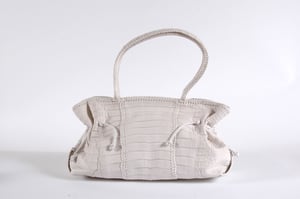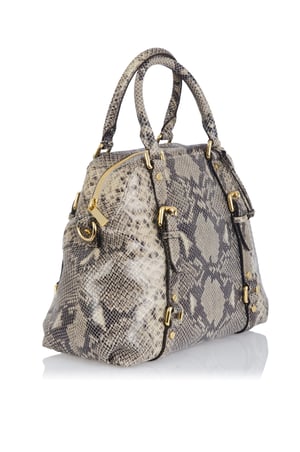 When it comes to making luxurious and unique handbags, few materials can rival the exotic appeal of crocodile skin. Crocodile hides have a very distinctive texture that make them instantly recognizable and distinct from common cowhide.
When it comes to making luxurious and unique handbags, few materials can rival the exotic appeal of crocodile skin. Crocodile hides have a very distinctive texture that make them instantly recognizable and distinct from common cowhide.
However, there are other exotic materials on the market that may rival the exotic appeal and luxury of crocodile leather for handbags. One such material is python skin.
Comparing Sizes for Handbags
Handbags typically require very large panels. To craft a large handbag with a single hide per panel, you need a large, grade I skin to work with, since there’s not really any room to hide the imperfections of a grade II or lower skin.
Both crocodile and python skins come in sizes that are easily large enough for almost any handbag panel (and even luggage-size panels in the case of crocodile).
For example, some species of python can grow to be 6.5 meters long, and 60 cm wide. With a hide of this size, filling multiple handbag panels is possible with a single skin. On the other end of the spectrum, a “small” python hide may be roughly 1.5 meters long and 25 cm wide; probaby not big enough for handbag panels.
Crocodile skins can vary greatly in size depending on species. For example, the caiman crocodile is typically only 4-6 feet long, but the Nile and American crocodiles average up to 14 feet long in the wild.
Larger crocodilian hides can easily fill multiple panels for a handbag design, and still have material to spare. However, large grade I crocodile hides are in extremely high demand, making them more difficult to find than python hides.
Flexibility of Python and Crocodile Hides
 For larger handbags that don’t use a structured style, the handbag material has to be able to flex without creasing to maximize useful life and attractiveness. After all, high-fashion clients don’t want to tote around a cracked bag.
For larger handbags that don’t use a structured style, the handbag material has to be able to flex without creasing to maximize useful life and attractiveness. After all, high-fashion clients don’t want to tote around a cracked bag.
The different crocodile species each have different levels of rigidity according to the calcium content of the hide. Of the commonly-traded crocodile hides, caiman skin is the boniest and least flexible, making it more prone to showing crease marks when flexed. Nile crocodile skin and American alligator skin rank in the middle, having some calcium deposits in their hides, but not as much as caiman crocs. The American crocodile (crocodylus acutus), has no bone content in the plates of its hide, rendering it much more flexible than its Nile and caiman counterparts.
Virtually all types of python skins make for extremely flexible leather goods, and are very resistant to creasing, making them an ideal handbag material.
Comparing Appearance
Both python and crocodile skins are very easy to distinguish from common cowhide. The large scales of a crocodile create a clean, but distinct, look for high-fashion accessories.
Python skins, on the other hand, have much smaller and more intricate scales compared to the broad plates of an alligator hide. Yet, these skins also commonly feature intricate natural markings and color patterns that can capture attention wherever the wearer goes.
The markings on python skins are a common reason why many designers choose to use unbleached python leather. For those who want a “clean” look, bleached python skins are also available.
So, which type of exotic skin is better for your next handbag project?
That depends on your budget and appearance preferences. If you need help choosing the perfect exotic leather for your next project, contact an exotic leather expert today!



